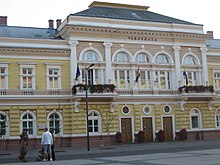Szolnok
| Szolnok | ||||
|
||||
| Basic data | ||||
|---|---|---|---|---|
| State : | Hungary | |||
| Region : | Northern Great Plain | |||
| County : | Jász-Nagykun-Szolnok | |||
| Small area until December 31, 2012 : | Szolnok | |||
| District since 1.1.2013 : | Szolnok | |||
| Coordinates : | 47 ° 10 ' N , 20 ° 12' E | |||
| Area : | 187.23 km² | |||
| Residents : | 74,544 (Jan. 1, 2011) | |||
| Population density : | 398 inhabitants per km² | |||
| Telephone code : | (+36) 56 | |||
| Postal code : | 5000, 5001 | |||
| KSH kódja: | 27854 | |||
| Structure and administration (as of 2016) | ||||
| Community type : | city | |||
| Mayor : | Ferenc Szalay (Fidesz-KDNP) | |||
| Postal address : | Kossuth tér 9 5000 Szolnok |
|||
| Website : | ||||
| (Source: A Magyar Köztársaság helységnévkönyve 2011. január 1st at Központi statisztikai hivatal ) | ||||
Szolnok ([ ˈsolnok ]; German Sollnock ) is a Hungarian city in the district of the same name . It is the seat of the county Jász-Nagykun-Szolnok and has even the rights of a county .
The city has 71,765 inhabitants (as of 2017), of which 33,100 are Catholic and 35,589 are non-denominational.
geography
Szolnok is located in the center of the county at the confluence of the Zagyva into the Tisza and extends over 18,723 hectares.
history
Around 1030 the castle of the county chief was built in Szolnok and named after his name Zounok . The name of the city is mentioned for the first time in 1075.
From 1552 to 1685 the city was under Ottoman rule.
As a result, the town developed into a trading center for salt and wood processing thanks to the salt transport on the Tisza, which was carried out with rafts .
In the 19th century, the traffic infrastructure was systematically improved through the regulation of the Tisza and the construction of the railway ( Pest – Szolnok line opened in 1843). In 1881 Szolnok had 18,247 Hungarians who were engaged in agriculture, trade, fishing and trading in fruit, timber, etc.
The ancestors of the composer Joseph Haydn came from Szolnok and later emigrated to Burgenland . Around 1850 the Viennese painter August von Pettenkofen founded the Szolnok School of Painting , a painters' colony to which "the Puszta painter" Johann Gualbert Raffalt , Theodor von Hörmann and later Tina Blau also belonged. Thanks to the special lighting conditions there, interesting landscapes were created that had a lasting influence on Austrian landscape painting . Representations of Hungarian peasant scenes are particularly typical, e.g. B. from markets, farms and wagons.
Until the First World War the city was a garrison of the Austro-Hungarian army. In 1914 the 1st Battalion of the Hungarian Infantry Regiment Freiherr von Reicher No. 68 was located here.
On December 24, 1963, a serious rail accident occurred near Szolnok when two trains collided. 45 people died.
economy
There is the Szolnok University of Trade and Economics and an institute for the training of air officers.
Town twinning
-
 Riihimäki in Finland since 1969
Riihimäki in Finland since 1969 -
 Reutlingen in Germany since 1990
Reutlingen in Germany since 1990 -
 Baia Mare in Romania since 1990
Baia Mare in Romania since 1990 -
 Bielsko-Biała in Poland since 1995
Bielsko-Biała in Poland since 1995 -
 Forlì in Italy since 1998
Forlì in Italy since 1998 -
 Shoham in Israel since 2001
Shoham in Israel since 2001 -
 Yuza (Yamagata) in Yamagata Prefecture in Japan since 2004
Yuza (Yamagata) in Yamagata Prefecture in Japan since 2004 -
 Eastwood (Nottinghamshire) in England since 2006
Eastwood (Nottinghamshire) in England since 2006 -
 Rakvere in Estonia
Rakvere in Estonia -
 Sanmenxia in China
Sanmenxia in China -
 Jinzhong in China
Jinzhong in China -
 Bengbu in China
Bengbu in China
sons and daughters of the town
- Miklós Világhy (1916–1980), lawyer
- Sándor Szűcs (1921–1951), football player
- Márton Szipál (1924–2016), photographer
- Csaba Gyula Horváth (1930-2004), Hungarian-American chemical engineer
- Mária Varjú-Ember (1931–2001), writer, victim of National Socialism
- Tivadar Kanizsa (1933–1975), water polo player
- Pál Nagy (* 1935), fencer
- Imre Szekeres (* 1950), politician
- István Tóth (* 1951), wrestler
- Erzsébet Németh (* 1957), badminton player
- József Bozsó (* 1960), badminton player
- Emőke Szilassy (* 1961), badminton player
- Tibor Fogarasi (* 1969), chess player
- Tamás Varga (* 1975), water polo player
- Zoltán Kővágó (* 1979), discus thrower
- Dániel Tőzsér (* 1985), football player
- Hedvig Karakas (* 1990), judoka
- Ágnes Bukta (* 1993), tennis player
Web links
- Official website of the city (German)
- Szolnok , in: A Pallas nagy lexikona (Hungarian)
- Szolnok transmitter (German, English)
- Aerial views over Szolnok
- Illustration by Johan Sibmacher from 1665: True Conterfactur Der Vöstung Zolnock As The Vom Turcken Occupied And Taken, Anno 1552 ( digitized )
Individual evidence
- ^ Austrian Gallery Belvedere (ed.): The Szolnok School of Painting. A Szolnoki festőiskola. Self-rel. the Austrian Gallery, Vienna 1975.
- ^ Peter WB Semmens: Catastrophes on rails. A worldwide documentation . Transpress, Stuttgart 1996, ISBN 3-344-71030-3 , p. 168.
- ↑ Szolnok: Testvérvárosaink. City of Szolnok, accessed June 19, 2018 (Hungarian).



